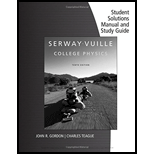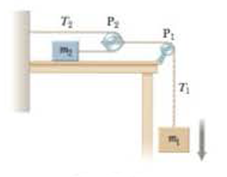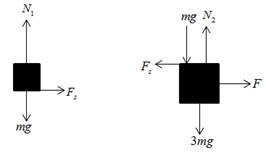
An object of mass m1 hangs from a string that passes over a very light fixed pulley P1 as shown in Figure P4.68. The string connects to a second very light pulley P2. A second string passes around this pulley with one end attached to a wall and the other to an object of mass m2 on a frictionless, horizontal table, (a) If a1 and a2, are the accelerations of m1 and m2, respectively, what is the relation between these accelerations? Find expressions for (b) the tensions in the strings and (c) the accelerations a1 and a2? in terms of the masses m1 and m2. and g.

Figure P4.68
(a)
Answer to Problem 68AP
Introduction:
The acceleration produces on the masses or bodies due to the application of external forces on it. In the presence of external force the acceleration produced in the same direction as that of the force.
Explanation of Solution
Here the two masses are affected by tensions and those are the reasons for the acceleration of the two masses
The tensions those are affected on the strings are same. Thus the acceleration on the mass
Conclusion:
Therefore, the acceleration on mass
(b)
Answer to Problem 68AP
Solution:
The magnitude of tensions are
Explanation of Solution
Given Info:
The acceleration of mass



Write the expressions for tensions on two strings attached by two masses.
Write (I) in terms of
Write the relation between the two accelerations.
Rewrite the equation (III) using (IV).
Rewrite (II) in terms of
Write the expression for tension in pulley 2.
Rewrite the above expression in terms of
Substitute (VI) and (VII) in (V) to calculate
Substitute (VIII) in (VII) to calculate
Conclusion:
Therefore, the magnitude of tensions are
(c)
Answer to Problem 68AP
Solution:
The magnitude of accelerations
Explanation of Solution
Given Info:
Write the formula to calculate
Use
Substitute the above expression in (IV) to calculate
Conclusion:
Therefore, the magnitude of accelerations
Want to see more full solutions like this?
Chapter 4 Solutions
EBK STUDENT SOLUTIONS MANUAL WITH STUDY
- pls help on thesearrow_forward20. Two small conducting spheres are placed on top of insulating pads. The 3.7 × 10-10 C sphere is fixed whie the 3.0 × 107 C sphere, initially at rest, is free to move. The mass of each sphere is 0.09 kg. If the spheres are initially 0.10 m apart, how fast will the sphere be moving when they are 1.5 m apart?arrow_forwardpls help on allarrow_forward
- 19. Mount Everest, Earth's highest mountain above sea level, has a peak of 8849 m above sea level. Assume that sea level defines the height of Earth's surface. (re = 6.38 × 106 m, ME = 5.98 × 1024 kg, G = 6.67 × 10 -11 Nm²/kg²) a. Calculate the strength of Earth's gravitational field at a point at the peak of Mount Everest. b. What is the ratio of the strength of Earth's gravitational field at a point 644416m below the surface of the Earth to a point at the top of Mount Everest? C. A tourist watching the sunrise on top of Mount Everest observes a satellite orbiting Earth at an altitude 3580 km above his position. Determine the speed of the satellite.arrow_forwardpls help on allarrow_forwardpls help on allarrow_forward
- 6. As the distance between two charges decreases, the magnitude of the electric potential energy of the two-charge system: a) Always increases b) Always decreases c) Increases if the charges have the same sign, decreases if they have the opposite signs d) Increases if the charges have the opposite sign, decreases if they have the same sign 7. To analyze the motion of an elastic collision between two charged particles we use conservation of & a) Energy, Velocity b) Momentum, Force c) Mass, Momentum d) Energy, Momentum e) Kinetic Energy, Potential Energyarrow_forwardpls help on all asked questions kindlyarrow_forwardpls help on all asked questions kindlyarrow_forward
 Principles of Physics: A Calculus-Based TextPhysicsISBN:9781133104261Author:Raymond A. Serway, John W. JewettPublisher:Cengage Learning
Principles of Physics: A Calculus-Based TextPhysicsISBN:9781133104261Author:Raymond A. Serway, John W. JewettPublisher:Cengage Learning Glencoe Physics: Principles and Problems, Student...PhysicsISBN:9780078807213Author:Paul W. ZitzewitzPublisher:Glencoe/McGraw-Hill
Glencoe Physics: Principles and Problems, Student...PhysicsISBN:9780078807213Author:Paul W. ZitzewitzPublisher:Glencoe/McGraw-Hill Classical Dynamics of Particles and SystemsPhysicsISBN:9780534408961Author:Stephen T. Thornton, Jerry B. MarionPublisher:Cengage Learning
Classical Dynamics of Particles and SystemsPhysicsISBN:9780534408961Author:Stephen T. Thornton, Jerry B. MarionPublisher:Cengage Learning Physics for Scientists and Engineers: Foundations...PhysicsISBN:9781133939146Author:Katz, Debora M.Publisher:Cengage Learning
Physics for Scientists and Engineers: Foundations...PhysicsISBN:9781133939146Author:Katz, Debora M.Publisher:Cengage Learning Physics for Scientists and Engineers with Modern ...PhysicsISBN:9781337553292Author:Raymond A. Serway, John W. JewettPublisher:Cengage Learning
Physics for Scientists and Engineers with Modern ...PhysicsISBN:9781337553292Author:Raymond A. Serway, John W. JewettPublisher:Cengage Learning Physics for Scientists and EngineersPhysicsISBN:9781337553278Author:Raymond A. Serway, John W. JewettPublisher:Cengage Learning
Physics for Scientists and EngineersPhysicsISBN:9781337553278Author:Raymond A. Serway, John W. JewettPublisher:Cengage Learning





